To build and preserve your milk supply when your baby is unable to breastfeed effectively, regular milk expression is essential. Expressing milk not only ensures a steady supply but also provides nourishment for your baby—even small quantities of breast milk offer invaluable nutritional and immunological benefits.
Timing for Initiating Pumping
If breastfeeding cannot begin immediately after birth, it is critical to start pumping within the first 6 hours postpartum. Early initiation significantly impacts long-term milk production, as delayed expression may reduce supply potential.
Selecting the Right Pump
For optimal results, a hospital-grade double electric pump (e.g., Medela, Ameda, or Hygeia models) is strongly recommended. These pumps are designed for frequent use, mimic natural nursing rhythms, and efficiently stimulate milk production. If renting a hospital-grade pump isn’t feasible, consider purchasing a high-quality double electric pump or combining hand expression with a single pump to maintain supply.
Recommended Milk Production Targets When Direct Nursing Is Not Possible
New mothers should aim to pump approximately 750-800 mL (25-27 oz) daily by 7-10 days postpartum, adjusting to 800-950 mL (27-32 oz) for twins or multiples by day 14. These targets align with research showing that early milk volume strongly correlates with long-term breastfeeding success. Regular monitoring of 24-hour output is critical: at 10 days postpartum, a supply below 350-500 mL (11-17 oz) may require interventions like galactagogues or lactation support.
Pumping Frequency Guidelines
To establish and maintain supply, pump 8-10 times daily, ensuring at least one session occurs overnight during the first few months. Prioritize consistency over rigid scheduling—even short, incomplete sessions can stimulate production. Avoid exceeding 5-6 hours between pumps early on, as prolonged gaps may reduce output. For mothers of multiples, higher frequency (e.g., 10+ sessions) is often necessary.
Nighttime Tip: Pump when naturally awake (e.g., due to breast fullness) rather than setting alarms, as this aligns with circadian hormonal patterns and improves milk yield.
Optimizing Pumping Sessions
- Early postpartum (before milk comes in): Use hand expression for colostrum, followed by double pumping for 10-15 minutes/session to stimulate supply.
- After milk transitions (mature milk): Extend sessions to 30 minutes or continue pumping 2-5 minutes after milk flow stops to empty breasts thoroughly.
- For partial nursing: Double pump 10-15 minutes post-feeding and employ breast massage/compressions to enhance drainage.
Optimized Guidance for Enhancing Milk Production:
Prioritize Rest and Stress Management
Adequate rest and relaxation are foundational for maintaining optimal lactation. Stress-reduction techniques such as mindfulness or brief naps can significantly support hormonal balance, particularly prolactin and oxytocin levels critical for milk synthesis.
Leverage Skin-to-Skin Contact
Implementing kangaroo care (prolonged skin-to-skin contact) stimulates oxytocin release, enhancing milk ejection and increasing pumping efficiency. This practice is especially beneficial for mothers of hospitalized infants.
Enhance Pumping Sessions with Sensory Stimuli
- Guided relaxation and music: Studies show combining soothing audio recordings with visual cues (e.g., baby photos) during pumping can triple milk output and elevate fat content in expressed milk.
- Pump synchronization: Begin with single-sided pumping if coordination is challenging, then transition to double pumping once comfortable. This ensures consistent breast stimulation.
Medication Awareness
Avoid substances that suppress lactation, including hormonal contraceptives, pseudoephedrine, alcohol, bromocriptine, and ergot derivatives. Consult healthcare providers to review all medications.
Galactagogue Considerations
If milk production remains suboptimal by 7-10 days postpartum, explore evidence-based galactagogues:
- Herbal options: Fenugreek (monitor for blood sugar interactions).
- Pharmaceuticals: Domperidone (Motilium) or metoclopramide (Reglan), which enhance prolactin activity. Always seek medical supervision for dosage and safety.


